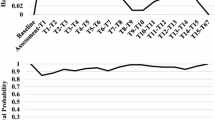Abstract
This study involved a comparison of dropout and nondropout community outpatients on a pool of demographic variables. Unlike previous studies, “dropout” was operationalized in terms of both session number cutoff and failure to appear for scheduled appointment(s). With the exception that early dropouts have had less previous therapy than later dropout or nondropout patients, no important group differences occurred. The findings combined to suggest that outpatient clinics “shape” patients into two groups: (1) those who make repeated use of a variety of mental health services and (2) those who quickly turn away from such services and are unlikely to reapply at a later date.
Similar content being viewed by others
References
Auld, F., & Myers, J. K. Contributions to a theory for selecting psychotherapy patients.Journal of Clinical Psychology, 1954,10, 56–57.
Brandt, L. W. Studies of dropout patients in psychotherapy: A review of findings.Psychotherapy: Theory, Research, and Practice, 1965,2, 6–12.
Frank, J. D., Gliedman, L. H., Imber, S. D., Nash, E. H., & Stone, A. R. Why patients leave psychotherapy.Archives of Neurology and Psychiatry, 1957,77, 283–299.
Gallagher, E. B., & Kanter, S. S. The duration of outpatient psychotherapy.Psychiatric Quarterly Supplement 1961,35, 312–331.
Garfield, S. L., & Affleck, D. C. An appraisal of duration of stay in outpatient psychotherapy.Journal of Nervous and Mental Disease, 1959,129, 492–498.
Gibby, R. G. Prediction of duration of therapy from the Rorschach Test.Journal of Consulting Psychology, 1953,17, 348–354.
Gibby, R. G. Validation of Rorschach criteria for predicting duration of therapy.Journal of Consulting Psychology, 1954,18, 185–191.
Gliedman, L. H. Incentives for treatment related to remaining or improving in psychotherapy.American Journal of Psychotherapy, 1957,11, 589–598.
Hiler, E. W. An investigation of psychological factors associated with premature termination of psychotherapy. Unpublished Ph.D. Dissertation, University of Michigan, 1954, cited in L. W., Brandt. Studies of dropout patients in psychotherapy: A review of findings.Psychotherapy: Theory, Research, and Practice, 1965,2, 6–12.
Hiler, E. W. Wechsler-Bellevue Intelligence as a predictor of continuation in psychotherapy.Journal of Clinical Psychology, 1958,14, 544–549.
Hiler, E. W. The sentence completion test as a predictor of continuation in psychotherapy.Journal of Consulting Psychology, 1959,23, 544–549.
Imber, S. D., Nash, E. H., & Stone, A. R. Suggestibility, social class, and the acceptance of psychotherapy.Journal of Clinical Psychology, 1956,12, 341–352.
Kurland, S. H. Length of treatment in a mental hygiene clinic.Psychiatric Quarterly Supplement, 1956,30, 83–90.
Lorr, M., Katz, M., & Rubinstein, B. A. The prediction of length of stay in psychotherapy.Journal of Consulting Psychology, 1958,22, 321–327.
Mahrer, A. R. Some known effects of psychotherapy and a reinterpretation.Psychotherapy: Theory, Research and Practice, 1970,7, 186–191.
Mahrer, A. R. Motivational theory: Foundations of personality classification. In A. R. Mahrer (Ed.),New approaches to personality classification. New York: Columbia University Press, 1970, 239–276.
Mahrer, A. R. The human relations center: Community mental health from a motivational perspective.Corrective Psychiatry and Journal of Social Therapy.
Meltzoff, I., & Kornreich, M.Research in psychotherapy. New York: Atherton Press, 1970.
Rosenthal, D., & Frank, J. D. The fate of psychiatric clinic outpatients assigned to psychotherapy.Journal of Nervous and Mental Disease, 1958,127, 330–343.
Rubenstein, E. A., & Lorr, M. A. A comparison of terminators and remainers in outpatient psychotherapy.Journal of Clinical Psychology, 1956,12, 345–349.
Sarason, S. B., Levine, M. I., Goldenberg, I., Cherlin, D. L., & Bennett, E. M.Psychology in community settings: Clinical, educational, vocational, social aspects. New York: Wiley, 1966.
Sullivan, P. L., Miller, C., & Smelser, W. Factors of length of stay and progress in psychotherapy.Journal of Consulting Psychology, 1958,22, 95–101.
Winder, A., & Hersko, M. The effect of social class on length and type of psychotherapy.Journal of Clinical Psychology, 1955,11, 77–79.
Author information
Authors and Affiliations
Additional information
This study was completed by the senior author in partial fulfillment of the requirements for the degree of Master of Arts at Miami University, Oxford, Ohio. The authors wish to thank the staff of the Lake County Mental Health Center, Waukegan, Illinois for their support of this effort.
Rights and permissions
About this article
Cite this article
Fiester, A.R., Mahrer, A.R., Giambra, L.M. et al. Shaping a clinic population: The dropout problem reconsidered. Community Ment Health J 10, 173–179 (1974). https://doi.org/10.1007/BF01410896
Issue Date:
DOI: https://doi.org/10.1007/BF01410896




